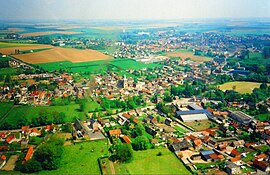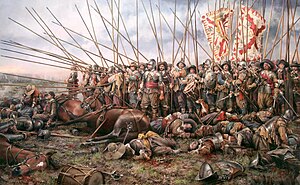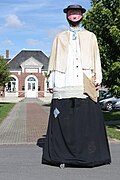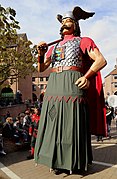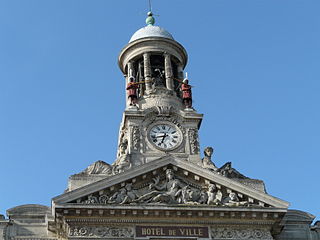
Cambrai, formerly Cambray and historically in English Camerick or Camericke, is a city in the Nord department and in the Hauts-de-France region of France on the Scheldt river, which is known locally as the Escaut river.

Le Cateau-Cambrésis is a commune in the Nord department in northern France. The term Cambrésis indicates that it lies in the county of that name which fell to the Prince-Bishop of Cambrai. Le Cateau station has rail connections to Paris, Maubeuge and Saint-Quentin.

The arrondissement of Cambrai is an arrondissement of France in the Nord department in the Hauts-de-France region. It has 116 communes. Its population is 162,045 (2016), and its area is 901.6 km2 (348.1 sq mi).
The following is a list of the 41 cantons of the Nord department, in France, following the French canton reorganisation which came into effect in March 2015:

Caudry is a commune in the Nord department in northern France. Its inhabitants are called the 'Caudrésiens'. The town is mostly known as the Capital City of French Lace. Caudry station has rail connections to Douai, Cambrai, Paris, Lille and Saint-Quentin.

Saint-Souplet is a commune in the Nord department in northern France.

The Polytechnic University of Hauts-de-France, previously known as University of Valenciennes and Hainaut-Cambrésis until 1 January 2018, is a French public university, based in Valenciennes. It is under the Academy of Lille and is a member of the European Doctoral College Lille-Nord-Pas de Calais and of the Community of Universities and Institutions (COMUE) Lille Nord de France.
The Chemin de fer du Cambrésis was a 120-kilometre (75 mi) long metre gauge railway in the Nord and Aisne departments of France. There were four lines with Caudry at the centre.

Villers-Plouich is a commune in the Nord department in northern France, situated 14 km south-west of the town of Cambrai.

François-Xavier Villain was a member of the National Assembly of France. He represented the Nord department, from 2002 to 2017 and is a member of Arise the Republic, a small Gaullist party led by Nicolas Dupont-Aignan. He is also mayor of Cambrai.
The canton of Le Cateau-Cambrésis is an administrative division of the Nord department, northern France. Its borders were modified at the French canton reorganisation which came into effect in March 2015. Its seat is in Le Cateau-Cambrésis.
The canton of Caudry is an administrative division of the Nord department, northern France. It was created at the French canton reorganisation which came into effect in March 2015. Its seat is in Caudry.

Mulquinerie, is a landmark of French sartorial heritage and high craftsmanship, is the art of weaving and trading fine fabrics composed exclusively of linen: whether plain flax cloth, 'linon' or batiste. A 'mulquinier' was the artisan textile designer and weaver as well as the merchant of canvases. The mulquiniers were not only a subcategorization of the tisserand(e) artists (hand loom weavers; French pronunciation: [tisʀɑ̃]) but were also the traders of their own craft. This activity was predominantly developed within villages as a substantial rural proto-industry, hence mulquiniers working on métiers à tisser in their home' basement while breathing from "bahottes" or "blocures" to obtain the most propitious humidity levels.

The Lamour Watermill is a museum and arts centre located in Briastre, Hauts-de-France, France. The water-powered mill and its edifices were built in the year 1800. It was originally used for milling grain, but stopped its operations in the 1930s before being converted into a museum by the Belleval family in the late 1990s.

Institution Saint Michel: Collège and Lycée is a Catholic secondary school with boarding facilities located in Solesmes, France. Founded in 1924 by the Roman Catholic Archdiocese of Cambrai constituted in 580, it is now also contractually regulated by the Academy of Lille, a ramification of the French Ministry of National Education, Higher Education and Research. As of 2018, it welcomes within centuries-old châteauesque edifices around a thousand students from nearly a hundred municipalities within a radius extending twenty kilometers.
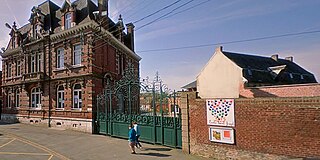
École Saint-Joseph is a French Catholic school ruled by the Ministry of National Education and based in Solesmes, Nord department, within the Hauts-de-France bordering Belgium. It was founded in 1892 by the Roman Catholic Archdiocese of Cambrai of the Latin Church and is attached to the Cambrai - Le Cateau-Cambrésis educational district contractually regulated by Lille. It is part of the Saint-Pierre consortium comprising schools in three other cities. The manor is a regional landmark due to its typical architecture. As of September 2018, it has more than three hundred pupils supervised by a staff of around forty agents.

The Selle is a river in the departments of Aisne and Nord, Hauts-de-France region, northern France. It flows into the Scheldt at Denain, southwest of Valenciennes, and approximately 20 km from the Belgian border. It is one of several rivers in France with the same name.
Communauté d'agglomération du Caudrésis et du Catésis is the communauté d'agglomération, an intercommunal structure, centred on the towns of Caudry and Le Cateau-Cambrésis. It is located in the Nord department, in the Hauts-de-France region, northern France. Created in 2011, its seat is in Beauvois-en-Cambrésis. Its area is 372.7 km2. Its population was 64,124 in 2019, of which 14,121 in Caudry.
Alexandre Dufosset is a French politician from National Rally.
